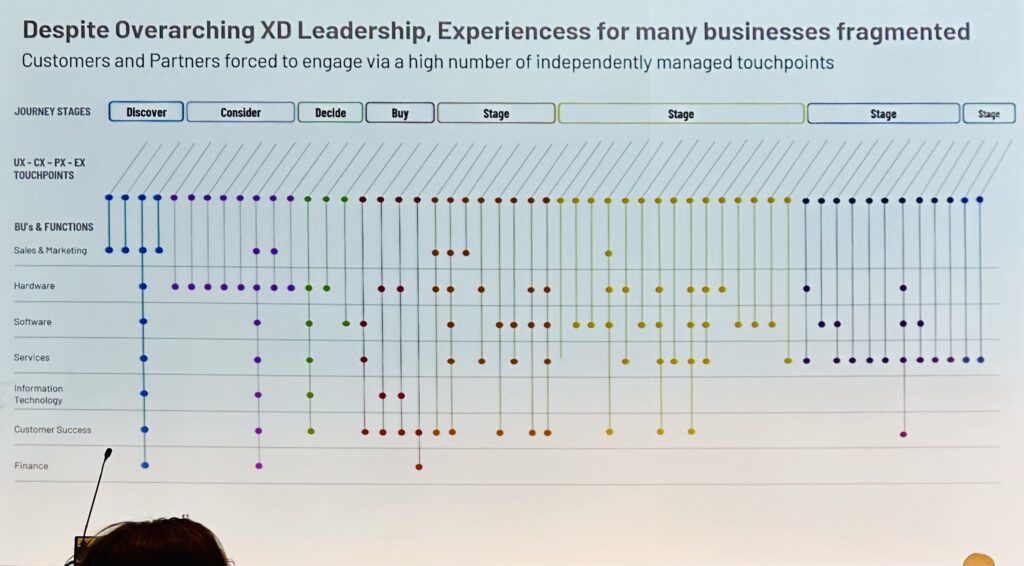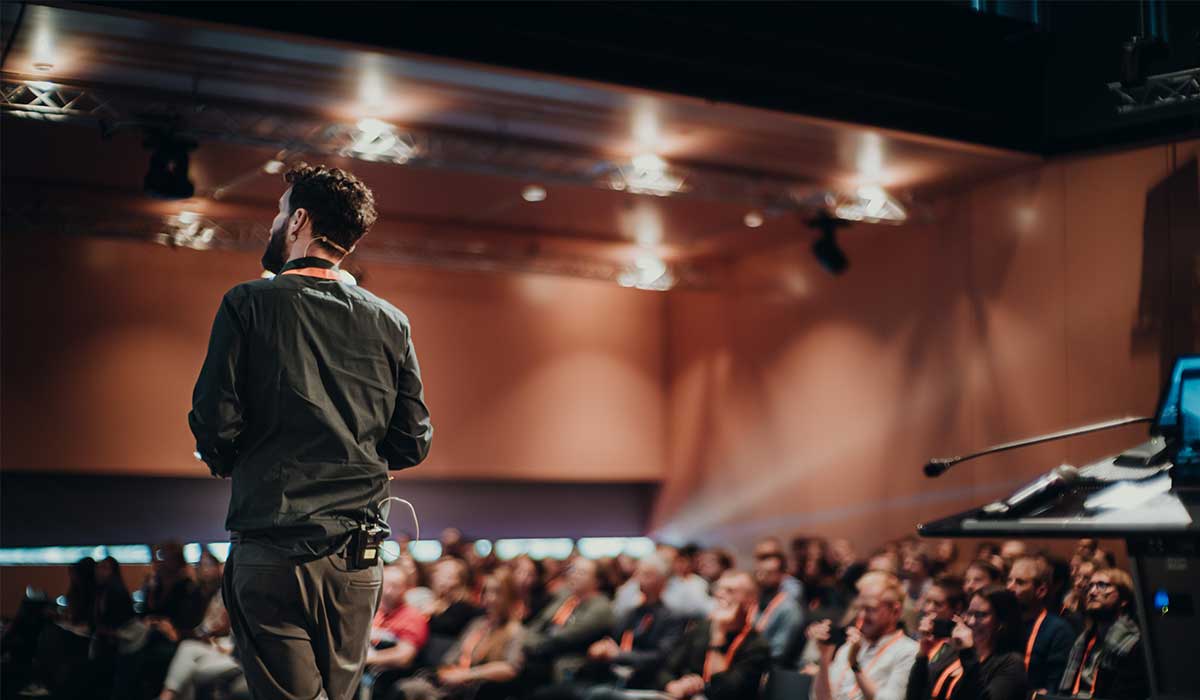This is the second part of notes from the conference talks. To learn more about the conference itself, please refer back to IMPULSE #1.
Crafting Cohesive Journeys for your Customers
Tim Scanlon, Rockwell Automation
Rapidly changing market dynamics impacting Customer Experience (CX) Many (often siloed) efforts within B2B companies address these opportunities with little coordination
- Evolving Customer Buying Behaviors
- B2C experience expectations in the B2B context around better buying experience (* Amazon can do it why can’t you?).
- Evolution of a digital workforce as demographic shifts affect our customers employee base.
- Complex globalized supply chains driving digitization and centralization of procurement processes. Shift to mobile and omnichannel experiences requires consistent and connected experiences across all touch points.
- New Partner + Supplier + Customer Ecosystems
- Shift to XaaS impacts customer touchpoints and requires reimagining of experience.
- Emergence of third-party marketplaces ex. Amazon Business, SAP Ariba, Coupa etc.
- More Integrated supply and MRO solutions (EX: Supply force, Grainger, Fastenal etc.)
- Industrial multi-brand E-commerce solutions (EX: Automation direct etc.)
- Disruptive Tech and Business Models
- Gen Al and delivery of adaptive customer interactions
- IOT – implications for enabling Maintenance Repair Operations (MRO) at point of need via telemetry
- As-A-service models transforming OEM/SI/Distributor roles/relationships
- Parsonalized Customer and Partner End-to-End Interactions
- Personalized Self Service and guided handoffs between departments are crucial to B28 end-to-end CX
- Predictive analytics to anticipate trends in customer service inquiries and proactively address issues affecting multiple customers, which can reduce support costs

Data first approach tool for tracking customer journeys: User-friendly Journey Management | TheyDo
Select CX Actions that directly impact business Outcomes:
Revenue 🟢
Cost 🔴
Resilience 🟡
- New Customer Acquisition 🟢
- Customer Retention 🟢
- Customer Enrichment 🟢
- Sales & Distribution Channels 🟢
- Cost of Acquiring New customers 🔴
- Cost of Serving Customers 🔴
- Cost of selling new products and services 🔴
- Operations, service, and delivery channels 🔴
- Business Continuity/ risk mitigation 🟡
- Financial Stability 🟡
- Brand Reputation 🟡
- Employee Experience 🟡
- Sustainability/ ESG 🟡
- Innovation 🟡
Enterprise Journey Management becomes a collaboration hub Single „version of truth“ connecting CX System to Insights, Opportunities, Solutions, Metrics
- Single source of truth for customer journeys, personas, insights, opportunities, solutions, goals and metrics.
- Activate journeys by prioritizing opportunities and solutions, enabling clear decision making for cross-functional collaboration.
- Ability to make data informed decisions based on clear relationships between Journeys insights, opportunities, solutions and goals.
- Critical Integrations to real-time data sources enable a direct link to solutions that solve customer problems.
3 Pragmatic Actions
Think Big, Start Small and Do something
- Complete a CX and Journey Management Capability Maturity Assessment. Benchmark. Prioritize gaps.
- Establish a standard „CX Data Model“. Ensure broad adoption and integration into mainstream systems connected to touchpoints in your end-to-end journeys. Customer Journey Stages (L1-L3) Personas (Internal & External) Metrics Industry/Application/Solution Mapping
- Prioritize CX Actions that are directly connected to high impact Outcomes for mission critical business objectives.
Key Take-away: Customer Journeys are not linear and a system level view brings these things together.
Leading the Experience Revolution: A Comedy of Errors and Triumphs
Helle Jensen, Valtech, Experience director
„UX Leadership – if you really really want to be manager you’re probably not going to be a good one“
- How can I move something today for myself and for my team?
- How can I change this organisation?
5 phases of misunderstanding
- Frustration (it’s so obvious)
- Disappointment (no one gets what we’re doing, no one gets the value of my work)
- Resentment (they always get it their way)
- Anger (this project is shit, I don’t want to work on this)
- Resignation (whatever, my soul is not in it)
Realign: Lean in to it. Make things right.
Don’t stick to the initial plan and realize where your team is at.
How do we deal with stakeholders?
- Connect perceived soft skills (UX and Design) to business objectives (numbers, KPIs)
- „Talk to Sales“ can’t usually be backed by data. Myth: „We know what the customer wants“. Talk to one customer – key to unlock more interviews
- Sow little seeds along the way. Highlight benefits. Emphasize avoided losses. Use business focus/ business benefits rather than UX benefits
- Use FOMO/ scarcity
- Social Proof
- Reciprocity – return the favor if you’ve done a favor (help them handle other stakeholders)
- Mirroring – show people that you understand them
- Foot in the door
- Making them think it was their idea. „As you pointed out earlier…(insert your idea)“
- Actively listen – be empathetic
UX Dream Team
- The most important thing about building a team is thinking about finding the right people. Not the best people. But how they work together. People dynamic affect each other.
- Figuring out the different personality types and how they solve problems
- Trusting gut feelings
- Telling people about your gut feeling and sharing those expectations and impressions
What mix of people Helen thinks makes the best team:
💛Yellow – involved, door swings open
❤️Red – decisive, take the lead
💙Blue – bring structure, make a plan, follow it
💚Green – people focused one, how is everyone feeling?
- everyone is a mix and of course people should not be put into boxes but she feels imagining the configuration helps her find the best solution for teams.
- It also depends on the task and mood
Have everyone’s back, no matter what stupid shit they do – because they did something. Maybe have a talk about if they’ll do it again in the future but have their back. Navigate the chaos. Embrace the chaos.
Always ask yourself: How can I excite people?
Building a UX-oriented organisational culture
Dominique Winter, OBI Group Holding SE & Co. KGaA / Die Produktwerker eG, Product Development Coach
Change means instability → The system of the organisation tries to stabilise itself.
Write Persona Stories → Perspektive der Persona einnehmen/ menschliche Perspektive einnehmen
For a new behavior, the people in the organization…
- …must be able to adopt the desired behavior,
- …be allowed to apply it,
- …be shown to do it (role modeling) and …be encouraged to do so by formal mechanisms.
Links:
User-friendly Journey Management | TheyDo
https://www.valtech.com/blog/i-just-need-a-redesign-and-a-mega-fast-horse
